| Hour
Ten
The
MG Lola was now running like clockwork, and the
car's pitstops were following a regular twelve-lap
schedule. Just before his first such stint came
to an end, Thomas Erdos passed the #30 Kruse Motorsport
Courage as it languished in the pits, elevating
the RML MG to 28th position. His stop, when it
came at 12:50am, was problem-free and routine,
and that allowed him to resume his challenge on
the #35 G-Force entry, catching and passing Gary
Pickering when the Londoner took to the pitlane
at ten past one.
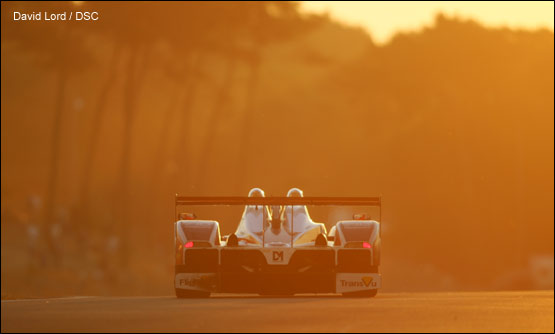
Fifteen
minutes later and one of the team's predicted
rivals in this race, the #30 Kruse Courage, hit
more problems, with an off at the Dunlop Chicane
soon after returning to the track, further reducing
its challenge in LMP2. Tommy meanwhile, was closing
on the #89 Sebah Automotive Porsche and also,
now, the #32 Intersport Lola. The one-time LMP2
leader had been encountering a succession of minor
woes, but they seemed to be increasing in seriousness.
Taking the Lola's position at the head of the
class had been the the #37 Belmondo Courage, followed
soon afterwards for second by its sister car,
the #36.
When
Gregor Fisken took the Intersport Lola back into
the pits five minutes later, it handed 26th place
and a potential foothold on the third step of
the LMP2 podium to RML's MG Lola. Tantalisingly
close, just a lap and a half ahead, lay the #36
Courage, but overall status was nearer at hand.
Erdos duly passed the Sebah Porsche, depriving
Dane Thorkild Thyrring of 25th place and setting
the #25 MG Lola in his stead.
At
half-past one Tommy's triple stint came to an
end, but what should have been another routine
and trouble-free handover to Mike Newton turned
out to be anything but. For no obvious reason
the electrics failed to revive when it came time
for Mike to drive out of the box. There was much
shaking of heads. There is nothing more frustrating
that an intermittent fault that proves so elusive
to track down. Once again, as had happened several
times before, the MG was dragged backwards into
the pit so that the whole cohort of engineers
and mechanics could set to work on the car. Outside
on the pit apron, only four personnel are permitted
to work on a car. Once inside the garage, any
number of people can be called upon to assist.
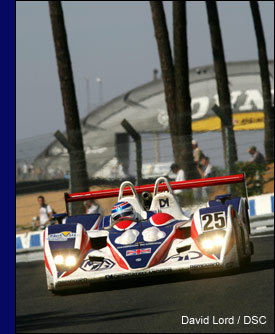 The
pause gave us a chance to catch up with the Brazilian,
and discover how his late-night run had gone.
"It went really well," he said, sounding
tired, but clearly exhilarated by having continued
Warren's fight-back so successfully. "It
was hard work. Early in my first stint, I lost
the paddle-shift, so I had to use the manual gearchange
from then on. That also meant reverting to right-foot
braking, which I've not had to do for a while."
His observations of the track conditions were
not exactly favourable, but concurred with the
feedback being received from other drivers. "It
was very, very slippery out there. There's just
so much cement dust, possibly too much, and it
has made parts of the track exceedingly slippy.
Thankfully, the tyres have been so good. They
just stay, stay, stay. Through the Porsche Curves,
and at Indianapolis, the car felt so stable, it
was fantastic." Casting concerned glances
to the garage from time to time, it was clear
that he was distressed to see much of his hard
work going for nothing. "This is all so frustrating,"
he shrugged. "All that work, and to regain
P3, and then this. I can't believe it." Alastair
Mcqueen agreed. "It was all going so well,"
he said. The
pause gave us a chance to catch up with the Brazilian,
and discover how his late-night run had gone.
"It went really well," he said, sounding
tired, but clearly exhilarated by having continued
Warren's fight-back so successfully. "It
was hard work. Early in my first stint, I lost
the paddle-shift, so I had to use the manual gearchange
from then on. That also meant reverting to right-foot
braking, which I've not had to do for a while."
His observations of the track conditions were
not exactly favourable, but concurred with the
feedback being received from other drivers. "It
was very, very slippery out there. There's just
so much cement dust, possibly too much, and it
has made parts of the track exceedingly slippy.
Thankfully, the tyres have been so good. They
just stay, stay, stay. Through the Porsche Curves,
and at Indianapolis, the car felt so stable, it
was fantastic." Casting concerned glances
to the garage from time to time, it was clear
that he was distressed to see much of his hard
work going for nothing. "This is all so frustrating,"
he shrugged. "All that work, and to regain
P3, and then this. I can't believe it." Alastair
Mcqueen agreed. "It was all going so well,"
he said.
Back to
top
Hour
Eleven
The
stoppage ended up at being almost half an hour
in length, and Mike was not back out and circulating
until just before two o'clock. The delay had dropped
the team to 26th place overall, with the Sebah
Porsche back in front once again, this time by
several laps. Mike's times, however, were far
more encouraging. Although some way short of his
earlier bests - well, this was the middle of the
night, after all, and he was driving on the manual
gearchange - they were still markedly quicker
than those of his rivals ahead.
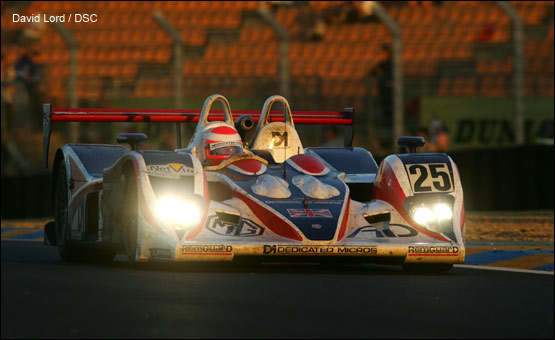
Hours
Twelve & Thirteen
The
remainder of this stint progressed without incident,
and Mike completed a refuelling pitstop at ten
to three without the feared electrical gremlin
rearing its head. Others were not so fortunate.
On the hour the #37 Courage hit a problem that
forced Belmondo to haul the car into the garage,
allowing Mike Newton to close to within less than
two laps, but he'd not have the chance to get
any closer. His next scheduled stop came up at
3:38, with the CEO of AD Group handing over driving
duties to Warren Hughes. Thankfully the car fired
up again without hesitation, and it was a matter
of moments before Hughes was roaring back out
along the pit exit. He soon found that same groove
that had served him so well earlier in the night,
and was posting times in the low three-fifties.
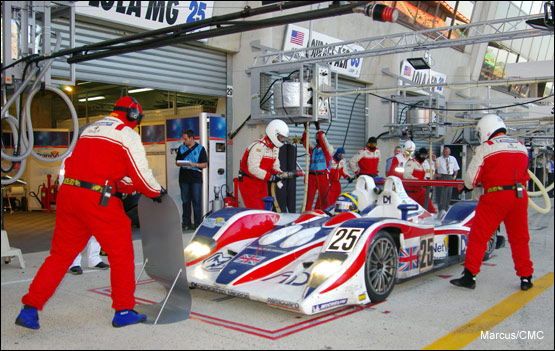
Rounding
off the twelfth hour of the race, and seeing the
RML MG Lola through to half distance, Warren Hughes
enjoyed a stress-free run well past four o'clock
and down to half-past. Just before his next scheduled
stop he posted one of his best laps of the race,
a 3:49.524, and by doing so carried the MG Lola
through to 25th place overall, passing the #37
Courage and making a first claim on second position
in LMP2. The class leader at the time was young
Adam Sharpe in the #36 car, a mere three laps
ahead.
Back to
top
Hour
Fourteen
Frustratingly,
it was all just a temporary elevation. The pitstop
when it came did not go smoothly, and after refuelling
the car, the car was trolleyed backwards into
the garage. Sure enough, four minutes later the
#37 Belmondo car wailed up the tribune canyon
to snatch back second in class and started to
pull out a meaningful lead. It would be a full
24 minutes in the garage for Warren before Phil
Barker waved him out and on his way once more,
this time with some tempting soft-compound rubber
on all four corners. The fickle finger of fate
was pointing both ways through this summer's night,
however, and both Belmondo cars would be serving
time in the garage before the race was another
hour older. The #37 was first to pit at two minutes
to five, followed moments later by the #36. First
in would be first out, just five minutes later,
but the #37 would languish for some time yet.
At five eighteen Hughes sailed serenely by, and
then rubbed salt into the wound by posting his
fastest lap of the race, not once, but three times.
His first improvement; 3:47.875, was followed
two laps later by an even quicker 3:47.649, and
then rounded off by a scintillating 3:47.601.
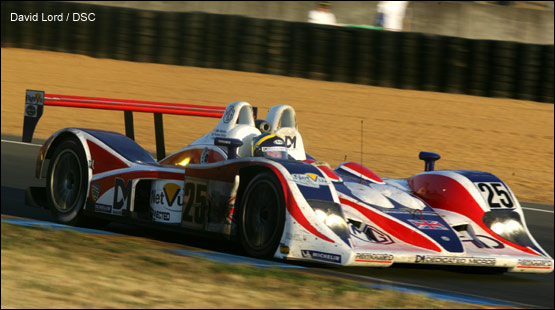
Hour
Fifteen
There
must have been a collective sigh of relief from
the RML garage when Warren completed a perfect
pitstop at five-forty. He was stationary for just
five minutes, and then rapidly back out on track
and lapping in the mid 3:50's or 53's, establishing
a firm grip on 24th place overall, second in LMP2.
The car had covered 178 laps of the 13.6 kilometer
Circuit du Sarthe.
The
team's next target was the Luc Alphand Porsche,
being piloted by Jerome Policand, four laps ahead.
Passing the #72 entry would not happen for a while,
and not while Warren was in the car. At just after
half-six he would hand over the MG to Thomas Erdos,
and once again, the dice would tumble favourably.
It was a straightforward and reassuringly rapid
pitstop that saw Erdos heading back into the fray
with barely a heartbeat missed. "We've just
got to try and keep this thing going," said
Warren. Another with similar views was Scot Allan
McNish, barging headlong into the tyrewall at
Indianapolis when a tyre failed on his Audi R8.
He got it back to the pits and the car was racing
again inside ten minutes. Not so Xavier Pompidou
in the T2M Porsche, suffering a massive impact
at the same corner. That car wouldn't be moving
again - ever - although Xavier was amazingly unscathed.
Back to
top
Hour
Sixteen
Thomas
Erdos marked the start of the sixteenth hour by
passing the #89 Sebah Porsche, static in the pits,
at five past seven. It was another notch on the
overall order, but far more important was the
next LMP2 place. That was still held by the #36
Belmondo Courage, and by twenty-past the margin
stood at less than two laps with Erdos closing
at a rate of fifteen or twenty seconds each lap.
In the opposite direction, he had a similar two-lap
cushion over the #37, but was adding comfort by
outpacing the second Belmondo car by 30 seconds
or more.
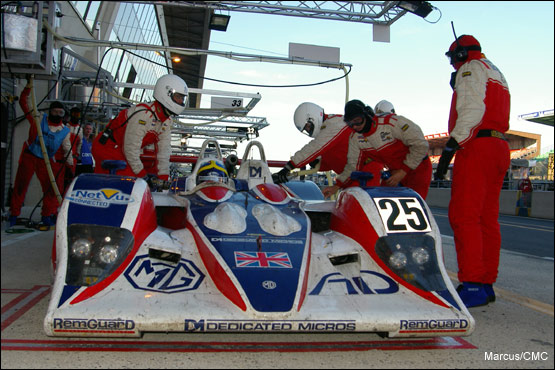
The
next scheduled pitstop came round at 7:33. Fingers
crossed, it went without a hitch. Slick and fast
and totally faultless, the car was dosed up with
fuel and Tommy sent on his way. "I hope we
finish. I really hope we do," said one of
the mechanics. This wasn't a plea; this was grim
determination.
Back to
top
Hours
Seventeen and Eighteen
The
battle in LMP2 has been fought as much in the
garages as on the track. Not one of the remaining
significant runners has enjoyed an easy passage,
and the #36 car was about to encounter another
patch of rough water. A conventional stop at ten
past eight was followed quarter of an hour later
by an unscheduled sojourn in the garage that would
last long enough to allow Tommy an unopposed claim
on 22nd overall. Bringing a far bigger cheer to
the RML garage, however, was the realisation that
this meant that the MG was now leading the class
for the first time. Sixteen hours previously such
an achievement might have seemed unlikely, but
a potent mix of perseverance, skill and mutual
encouragement can work wonders.
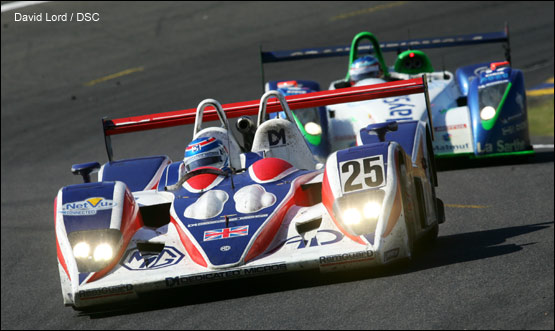
With
another faultless pitstop the prospects were suddenly
looking far more encouraging, and Erdos pressed
on confidently for another half hour. He passing
the #72 Luc Alphand Porsche just before the hour,
and then completed his stint by handing the MG
back to Mike Newton at 9:08. Not only was Mike
entrusted with the next stint, but he also had
the personal pleasure of knowing that his car
was now leading its class at Le Mans. It must
have been a very special sensation, made easier
to bear by the knowledge that he had a three-lap
lead over the #37 and four over the #36. Regrettably,
it was not going to last. At half past nine Mike
was back down the pitlane, and it wasn't a scheduled
stop. The car was barely at rest before the engine
cover was off. It didn't take a detailed examination
to confirm the problem. "We've got a gearbox
oil leak," acknowledged Ray Mallock. "One
of the castings may be cracked, so we're seeing
if we can fix it." Proof that this was the
culprit came from Jamie Campbell-Walter, who had
been following the MG when the fracture occurred.
He caught the oil and slid into the barriers at
the first Mulsanne chicane.
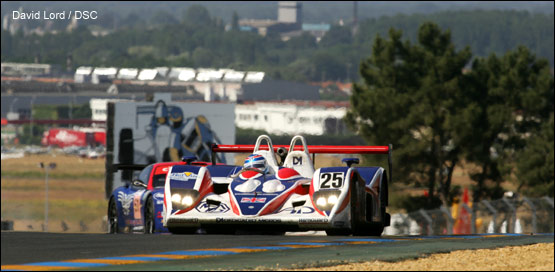
It
was desperately sad to see all that hard work
slipping through the team's proverbial fingers.
The Luc Alphand Porsche was the first to take
advantage, moving through to regain 21st place
at 9:40. Eight minutes later the #37 Courage reclaimed
the class lead, and then the #36 knocked the MG
down to third.
Back to
top
Hour
Nineteen
With
the car stationary in the garage the team’s
position on those podium steps was looking increasingly
fragile, and as the clock ticked past ten o’clock
the timing screens already confirmed that 25th
overall was third in LMP2, yet the likelihood
of slipping to fourth was imminent. The #30 Kruse
Courage, long since overtaken, was back up to
pace and only a few laps adrift.
As
it must always be throughout the story of this
race, all credit to the RML mechanics and engineers,
who completed the repair in record time. Weary
to the bone they may have been, but they never
wavered, and their efforts had Mike back out onto
the circuit and racing again by quarter past ten.
It was a close call. Tim Mullen in the Kruse entry
had moved ahead of the MG on the previous lap,
but had just arrived in the pitlane himself for
a lengthy, if scheduled, stop. It was a matter
if just a single lap of the track before Mike
had restored RML to that bottom step once more
and the road to recovery could be resumed.

Having
achieved so much, it really was starting to feel
like one step forward and two back. From the class
lead, Mike now faced a six-lap deficit on just
the first of the two Belmondos, yet he couldn’t
begin the task of reducing that margin just yet.
He was passing through the pitlane again after
a couple of laps for fuel, a full set of tyres
and, more importantly, a quick check-up of the
repair to make sure that everything was as it
should be. Passed fit for duty, the MG was soon
on its way.
Hour
Twenty
The
next half hour or so proved routinely uneventful
– something of a relief perhaps. Mike notched
into a rhythm of four-minute laps and that consolidated
the car’s position, and meant that Warren
was perfectly placed to take the fight back to
Team Belmondo when he clambered aboard for his
next double-stint at 11:12. The #36 had lost twenty
minutes in the pits just before the hour, so the
gap was down to spitting distance. Indeed, when
Mullen pitted at quarter past, it meant that all
three – the #36, the RML #25, and the Kruse
#30, were all on the same lap. The difference
was the relative speeds, and that suggested an
advantage in Hughes’ favour of fifteen to
twenty seconds with every lap completed.
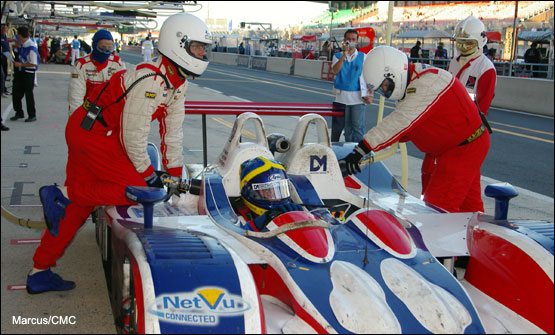
Sure
enough, by half past eleven the gap between the
tail of the #36 Belmondo and the MG’s nose
had been cut to less than a minute. By quarter-to
it was thirty seconds and every lap was bringing
them closer together. The retirement of the #17
Pescarolo, for so long a serious challenge and
French hope for the outright lead, went almost
un-noticed in the RML garage, because Hughes was
about to weave through the Ford chicane with that
red, white and blue nose tucked tight under the
rear wing of Adam Sharpe’s Courage. As they
crossed the line the gap was clocked at a mere
0.774 seconds, and as the noise from their engines
echoed between the grandstands, Hughes notched
the MG to the side and eased by. The second step
was RML’s once more.
Within
a lap Hughes had established a lead of fifteen
seconds. His times were all neatly bracketed around
the three-fifty-two mark, with a 3:51.930 following
a 3:52.937 following a 3:53.891. My midday, and
inside three laps, he’d moved clear of Sharpe
to the tune of 45 seconds.
Back
to top
Hours
Twenty-One and Twenty-Two
With
just under four hours to go – just?
That’s longer than most regular endurance
events! – Warren came in for a regular pitstop.
Five minutes later, so did Sharpe. They were shadowing
one another, but Warren’s shadow was lengthening
the quicker. He had continued to impose his dominance
over the young Briton in the French car, and the
gap had grown to more than a lap. In doing so,
Warren had also drawn closer to the #37, but the
margin was larger than he could hope to close
by raw speed and talent alone. By half past twelve
the MG Lola had covered 260 laps in total and
was lying 23rd overall, second in LMP2, but still
six laps adrift.
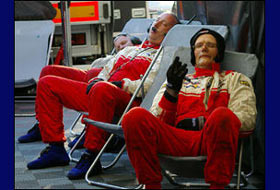 These
last hours before the chequered flag have a strange
detachment. There are crowds milling around the
stands and through the Village, but many are totally
oblivious of the action on the track. While the
cars continue to fly by just as fast as they ever
have, their drivers deep in concentration; hot
and tired, their arms and necks aching from the
constant strain and g-forces, it’s all too
easy to take them for granted. The bellow of a
passing car earns a casual glance, the pre-race
purity of its paintwork long since blemished by
an acne of dead flies, spent rubber and tank-tape,
but never underestimate the bravery of these guys.
Fuelled by adrenalin and determination, encouraged
by the support of seemingly tireless mechanics,
they push on regardless. It’s a humbling
thought. These
last hours before the chequered flag have a strange
detachment. There are crowds milling around the
stands and through the Village, but many are totally
oblivious of the action on the track. While the
cars continue to fly by just as fast as they ever
have, their drivers deep in concentration; hot
and tired, their arms and necks aching from the
constant strain and g-forces, it’s all too
easy to take them for granted. The bellow of a
passing car earns a casual glance, the pre-race
purity of its paintwork long since blemished by
an acne of dead flies, spent rubber and tank-tape,
but never underestimate the bravery of these guys.
Fuelled by adrenalin and determination, encouraged
by the support of seemingly tireless mechanics,
they push on regardless. It’s a humbling
thought.
Thomas
Erdos was about to become one such driver. At
five-to-one Warren Hughes’ final stint came
to an end as the soft-spoken Geordie handed over
responsibility for the last three hours to Tommy.
The first of those sixty minute batches was to
be pretty uneventful, with the RML MG moving smoothly
through to 22nd overall after passing the #89
Sebah Automotive Porsche – again
– and pulling three laps clear of the #36
Belmondo Courage. As the official electronic clock
on the Rolex gantry fluttered its digits over
to two-o’clock, the #37 Courage began its
289th lap, still with five laps in hand over the
chasing Erdos. I have a entry in my notebook that
simply states: ‘Only a miracle or a mistake
by the #37 can change the result’. Little
did I know what lay around the corner.
Hour Twenty-Three
The
corner in question turned out to be the Ford Chicane,
and the time was 2:07. As Tommy came onto the
brakes after negotiating the Porsche Curves, slowing
the car’s momentum into the first element,
misfortune cast her cards in equal measure. One
of the right rear suspension arms sheared from
its mounting, tipping the car into a series of
wild gyrations across kerb and gravel and coming
to rest just yards from the entrance to the pitlane.
“It snapped as soon as I went on the brakes,”
explained Erdos afterwards. “We were very
lucky that I didn’t hit anything, since
there was nothing I could do about it at all.”
Like a cruel test from the Gods, being so close
to the pits was a lifeline, but with less than
two hours remaining and with the #37 Belmondo
Courage already five laps clear and the #36 closing
fast, the result RML had started to dream of was
suddenly looking unlikely.
Back
in the garage there was a moment’s hesitation
as those watching the TV monitors gaped in disbelief
before instinct and training took over. Like ants
disturbed in their nest, red-suited RML personnel
were suddenly busying themselves for action. Tiredness
was wiped from their faces along with the sweat
as they hurried to take up the tasks they knew
were theirs. Phil Barker lived up to his name,
issuing commands with the minimum of words. While
others marvelled at the fact that the incident
had taken place at the very entrance to the pitlane,
four mechanics were already running towards the
car, Barker’s strict instructions not to
“cross the line” ringing in their
ears.
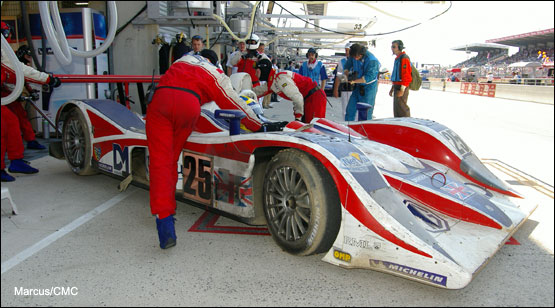
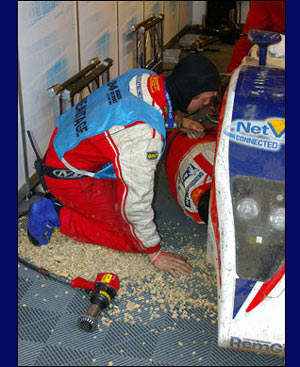 In
the end they weren’t needed. The marshals
had moved swiftly into action, and using one of
the Manitou recovery hoists, had pulled the MG
clear of the gravel and, as luck would have it,
hauled it towards the pit entry. Once on terra
firma Tommy was able to coax the car gently
back to the garage, crabbing slightly sideways
and with the right rear sunk low to the ground.
It was a desperately sorry sight, with the once
resplendent bodywork scarred not only by twenty-two
hours of hard racing, but now covered in the dust
and debris of a trip through the gravel. Every
available hand was on call to haul the car backwards
into the garage and then begin not only the repair
of the damaged suspension, but also the painstaking
removal of every last trace of the harsh sharp-edged
stone chippings used at Le Mans. It was a strangely
silent operation, the thunderous noise from the
racetrack as cars accelerated up the pit straight
drowning out and rendering useless any form of
speech inside the garage. It was superfluous anyway.
Save for a few shouted instructions from Barker,
his brigade knew the drill. It was impressive
to watch, and inspiring. There wasn’t a
single man amongst them that seemed to consider
for a moment that the race was over. After what
they’d already been through, their determination
was at once both staggering and admirable. In
the end they weren’t needed. The marshals
had moved swiftly into action, and using one of
the Manitou recovery hoists, had pulled the MG
clear of the gravel and, as luck would have it,
hauled it towards the pit entry. Once on terra
firma Tommy was able to coax the car gently
back to the garage, crabbing slightly sideways
and with the right rear sunk low to the ground.
It was a desperately sorry sight, with the once
resplendent bodywork scarred not only by twenty-two
hours of hard racing, but now covered in the dust
and debris of a trip through the gravel. Every
available hand was on call to haul the car backwards
into the garage and then begin not only the repair
of the damaged suspension, but also the painstaking
removal of every last trace of the harsh sharp-edged
stone chippings used at Le Mans. It was a strangely
silent operation, the thunderous noise from the
racetrack as cars accelerated up the pit straight
drowning out and rendering useless any form of
speech inside the garage. It was superfluous anyway.
Save for a few shouted instructions from Barker,
his brigade knew the drill. It was impressive
to watch, and inspiring. There wasn’t a
single man amongst them that seemed to consider
for a moment that the race was over. After what
they’d already been through, their determination
was at once both staggering and admirable.
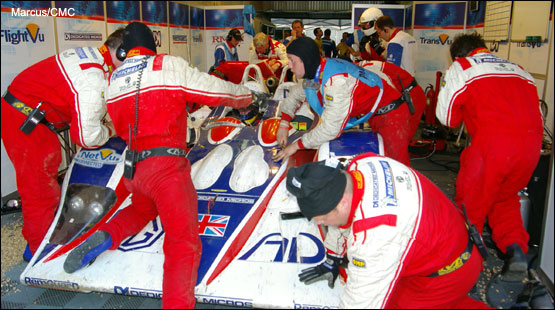
Throughout
the next half-hour Erdos sat impassively. A fan
had been set on the sidepod of the car to blow
air into his visor, his movements deliberate and
his thoughts unreadable. “I was thinking,
what else can possible go wrong?” he admitted
afterwards. “I was tired. I’d done
two triple-stints, and then doubles, and at the
end was in the car for three hours. I felt emotionally
drained. I was also a little concerned, because
it was a very unusual failure. I was worried that
the other side might go the same way.”
Behind
him the action continued unabated. While the left
side of the car was being rebuilt, the right hand
side was being painstakingly inspected. What had
happened once could happen again, and even at
this late stage in the race, nobody was prepared
to take chances with the car or, more important,
the man inside it. Amazingly, despite what looked
to be a violently physical accident, the rest
of the car had survived almost unscathed, confirming
the resilience of carbon-fibre construction. Nobody
was taking any chances though, and every nut,
bolt and accessible component that could be examined
was checked for tightness or damage.
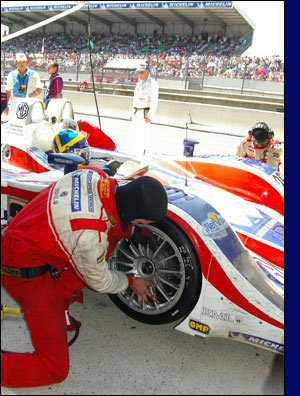 Amazingly,
within twenty minutes of arriving in the garage,
wheels were already going back on the EX264. They
glistened wetly as the bright lights reflected
off the smooth surface of the fresh rubber. Two
minutes later, the rear panel was being secured
in place over the engine and the car trolleyed
unceremoniously out of the garage, dumped on the
ground, and then raised on its jacks. Only then
were the race tyres fitted – pre-scrubbed
and ready for the track ahead. The team was taking
no chances, and had used the new tyres to wheel
the car across any remaining chippings on the
garage floor, saving the best for the track. Amazingly,
within twenty minutes of arriving in the garage,
wheels were already going back on the EX264. They
glistened wetly as the bright lights reflected
off the smooth surface of the fresh rubber. Two
minutes later, the rear panel was being secured
in place over the engine and the car trolleyed
unceremoniously out of the garage, dumped on the
ground, and then raised on its jacks. Only then
were the race tyres fitted – pre-scrubbed
and ready for the track ahead. The team was taking
no chances, and had used the new tyres to wheel
the car across any remaining chippings on the
garage floor, saving the best for the track.
At
two thirty-five, almost exactly thirty minutes
since he’d been lost to sight within a cloud
of dust at the Ford Chicane, Thomas Erdos barked
the MG Judd V8 into life and roared off up the
pitlane, leaving only the smallest trail of gravel.
It was a remarkable demonstration of determination,
bravery and skill, and only now did anyone turn
to the timing screens to see what the last hour
and a quarter offered. They were greeted by another
amazing twist in this already unbelievable tale:
not one, but both Belmondo Courages were also
in their garages. The leader, it was suggested,
had holed a piston, while the #36 was suffering
from an overheated starternator. “Those
are the very problems we always used to catch,”
said Mike Newton, referring to RML’s period
with the AER-engined EX257. Suddenly everyone
recognised that, despite the events of the previous
half-hour, and the considerable deficit the team
now faced, there was still a chance.
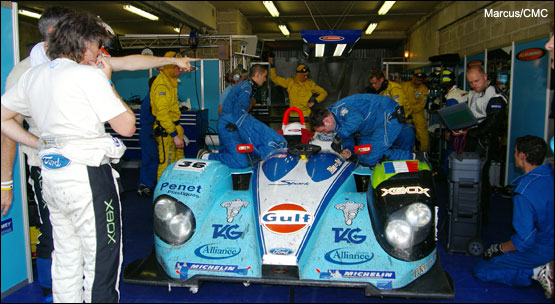
In
amongst all this had been a cruel coincidence.
The Aston Martin pitlane crew had occasionally
spilled over onto the RML box during the race,
when both their cars in the adjacent garage had
been expected close together. As the MG emerged
into the daylight after what must have looked
to many like a potential retirement, the refuelling
crew for the #58 had to step aside, but their
gaze didn’t waver. Peering over the MG and
her attendant personnel, they were scanning the
distant track for any sign of their car. Only
after the begrimed MG had hurtled away and the
noise of its departure faded into the distance
did they accept the stark reality that the DBR9
they were waiting for wouldn’t be coming
back. It had run out of fuel after more than twenty-two
hours. One can only begin to imagine their thoughts.
Back to
top
Finish
Meanwhile,
back in the RML garage, the team had one eye on
the screens, and another along the pitlane towards
the Belmondo garage. There was an air of high
tension, but Phil Barker suddenly had a skip in
his step as he ran across to the pitwall to consult
with Alastair Mcqueen. He, for one, knew the race
wasn’t over. Tommy had also discovered that
the car had survived this latest ordeal reasonably
well, and even if he couldn’t possibly match
the kind of pace he and Warren had demonstrated
earlier in the race, there was a good chance he
could overhaul the two Courages. Both had pulled
ahead in the class during the MG’s enforced
stop and were now several laps clear, albeit stationery.
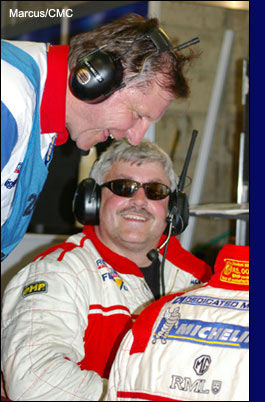 Under
strict instructions over the radio that there
were to be “no heroics” Erdos eased
back and started lapping in the mid four-tens.
So long as the two Belmondo cars remained in their
garage he had no need to push, and the strategy
worked. At 2:42 he came through to begin his next
lap, and overtook the #36 for second in LMP2.
That left the #37 still several laps in front,
but with a damaged engine did it pose a threat?
Incredibly, it did! Having had it confirmed that
the mechanics were not doing any work on the car,
it was with some incredulity that those watching
the monitors suddenly caught sight of the #37
leaving the pitlane. There was a collective sigh
of relief, however, when the car’s pace,
and the accompanying pall of smoke, confirmed
that it was going nowhere fast, even if it did
have five laps in hand. Trailing smoke and travelling
at pitlane speed, or slower, the car was being
accompanied around the circuit by a Mexican wave
of white flags. Under
strict instructions over the radio that there
were to be “no heroics” Erdos eased
back and started lapping in the mid four-tens.
So long as the two Belmondo cars remained in their
garage he had no need to push, and the strategy
worked. At 2:42 he came through to begin his next
lap, and overtook the #36 for second in LMP2.
That left the #37 still several laps in front,
but with a damaged engine did it pose a threat?
Incredibly, it did! Having had it confirmed that
the mechanics were not doing any work on the car,
it was with some incredulity that those watching
the monitors suddenly caught sight of the #37
leaving the pitlane. There was a collective sigh
of relief, however, when the car’s pace,
and the accompanying pall of smoke, confirmed
that it was going nowhere fast, even if it did
have five laps in hand. Trailing smoke and travelling
at pitlane speed, or slower, the car was being
accompanied around the circuit by a Mexican wave
of white flags.
Minutes
later the #36 also rejoined the race. Adam Sharpe
was back in the cockpit, but with a three-lap
arrears he had a lot of ground to make up. He
set about the task with some zeal, and was actually
matching Tommy’s pace at this stage. The
Brazilian was intent on making sure that, having
recovered so much, RML’s position wasn’t
about to be endangered by overstressing the MG.
“The engine was fantastic throughout,”
enthused the Brazilian some while later. “It
never missed a beat, and it was strong from start
to finish, but I wasn’t about to make it
do any more than we truly needed.” There
had been times when the team had pushed very hard
to make up lost ground, but this was an occasion
where discretion was needed.
When
the Belmondo car finally stuttered to a halt near
Maison Blanche at just after three, hoping to
wait there until the final lap and then crawl
across the line almost an hour later, the seal
had been set. At three-fifteen Tommy swept passed
the stationary car, and began his next lap as
class leader. There was hardly anyone in the RML
pit who could quite believe what they had just
gone through, but it wasn’t over yet. The
final hour of the Le Mans marathon may seem like
the end of the race to the spectators, but it
is nonetheless another sixty-minutes of sprint
racing, and some races don’t even last as
long. A final scheduled pitstop saw the MG refuelled,
re-tyred and smoothly back into action again with
barely a minute’s pause. If only all the
car’s pitstops could have gone so well.
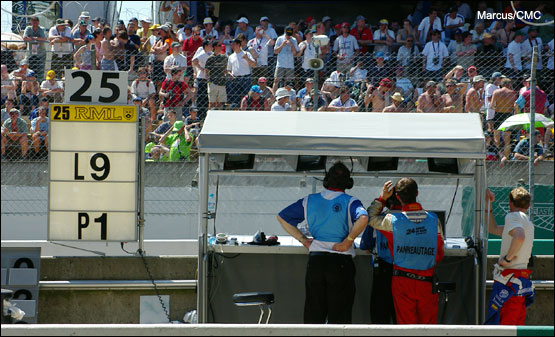
If
the challenge from the #37 had gone, the #36 Courage
was still in the chase. Tommy couldn’t afford
to ease back too much, and the 73rd running of
the Le Mans 24 Hours offered similar tension throughout.
In every class, there was a battle in progress
for the podium, with leaders and chasers each
within sight of the other. Not until the final
ten minutes did it appear that the protagonists
had accepted their fate, and while the overall
winners, two Audi R8s and the sole surviving Pescarolo
formed up to stage the perfect photo-finish, realisation
dawned upon the hot and weary faces around the
RML garage that the could actually win.
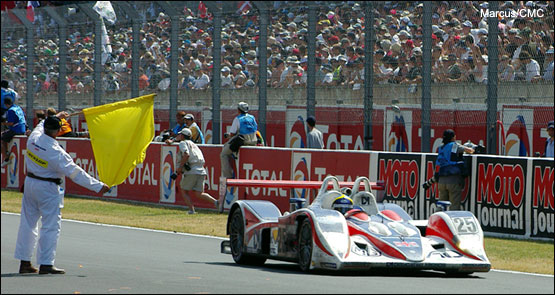
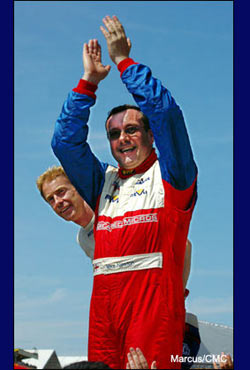 As
luck would have it – and didn’t it
always throughout this race? – Tommy was
ahead of the race leaders on the track, so the
finish had been staged for several minutes before
the glare of the MG’s headlights could be
seen glittering through the haze. It couldn’t
have worked better. With a flourish, the commentator
announced the arrival of the LMP2 winner. In solitary
splendour, and accompanied by an enormous cheer
from the crowd, the diminutive MG Lola EX264 wailed
its Judd-inspired battle-cry across the finish
line, Tommy pedalling the throttle into a crescendo
of defiance. Not only was he celebrating the finish
the team so much deserved; not just a podium,
but also that rare distinction, victory at Le
Mans. Mike Newton and Warren Hughes both climbed
high atop the pitwall to welcome home their car,
their feet swathed in the waving arms of a mass
of cheering and ecstatic team members, better
halves and sponsor’s guests. It was an enormously
emotional moment, and the relief that comes after
so many hours of strain and pressure was clear
for anyone to see. As
luck would have it – and didn’t it
always throughout this race? – Tommy was
ahead of the race leaders on the track, so the
finish had been staged for several minutes before
the glare of the MG’s headlights could be
seen glittering through the haze. It couldn’t
have worked better. With a flourish, the commentator
announced the arrival of the LMP2 winner. In solitary
splendour, and accompanied by an enormous cheer
from the crowd, the diminutive MG Lola EX264 wailed
its Judd-inspired battle-cry across the finish
line, Tommy pedalling the throttle into a crescendo
of defiance. Not only was he celebrating the finish
the team so much deserved; not just a podium,
but also that rare distinction, victory at Le
Mans. Mike Newton and Warren Hughes both climbed
high atop the pitwall to welcome home their car,
their feet swathed in the waving arms of a mass
of cheering and ecstatic team members, better
halves and sponsor’s guests. It was an enormously
emotional moment, and the relief that comes after
so many hours of strain and pressure was clear
for anyone to see.
The
final two hours of the race had produced some
of the most extraordinary motorsport likely to
be witnessed for some time. While motor racing
in America was making headlines for all the wrong
reasons, the greatest race of them all was demonstrating
just why Le Mans and legends go hand-in-hand.
Throughout the field, in every class and category,
there had been genuine competition and nail-biting
excitement. Nowhere was this more tangible than
in the RML garage, where triumph really had been
dragged kicking and screaming from the jaws of
apparent disaster.
One of the drivers suggested that the car itself
simply didn’t want to finish the race. At
every turn, no matter what hurdle the hard-working
team had ovecome, another obstacle would be thrown
in their faces. From the very first hour this
had been a rollercoaster race of despair and delight
– on the one hand, the frantic struggle
in the garage each time something went wrong,
and on the other, the sight of the MG EX264 and
one of its drivers blasting away up the pitlane
to begin another fight-back from ten laps down.
In
the end the RML MG Lola EX264 covered a total
of 305 laps on its way to winning LMP2, taking
24:05.45.284 hours to do so – the greatest
total time of any car in the race. The #36 Courage
C65 of Paul Belmondo Racing finished second on
300 laps, with the #37 sister car fourth on 294
laps. Fourth place fell to the #30 Kruse Courage
on 268 laps.
Back to
top
Conclusion
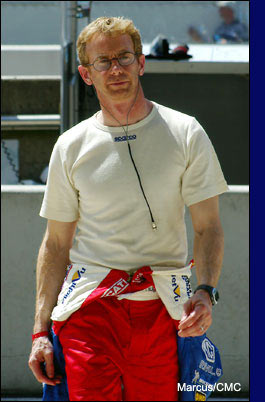 We
managed to get words out of the drivers after
the race, finding Warren sitting on the floor
in the driver’s rest room, elbows on knees
and hands clasped around his neck. We
managed to get words out of the drivers after
the race, finding Warren sitting on the floor
in the driver’s rest room, elbows on knees
and hands clasped around his neck.
“I have never seen a team of people work
so hard before, never,” he insisted, shaking
his head in disbelief. “Those boys just
wouldn’t give in. They’re the ones
who won this race, not us.” His voice, hoarse
from a flu-like bug, cannot hide his pride. “It’s
hard to live through that kind of experience,”
he continued. “It was just one thing after
another. It’s almost surreal. None of the
problems were related to the speed we were doing.
Even when we were forced into pushing, the things
that went wrong were nothing to do with that.
I was lucky though. My two triple stints, and
then that last double, were all relatively trouble-free.
Even during the night, the only glitch I had was
with the gearshift, and I had to switch to the
manual system.” This was actually quite
a frightening situation to be in. “The team
radioed a solution, and told me I had to switch
everything off going down the Mulsanne. All the
lights went out, everything!” He freewheeled
in the dark (at no mean speed!) before toggling
the appropriate controls and initiating the change
to manual. Thankfully, it worked.
“It’s
amazing to think that we didn’t touch one
car, didn’t have any unforced spins, and
we were quick all the way,” added Warren.
“The car was also the fastest [LMP2] in
the race. It wasn’t in qualifying, because
the others could turn up the boost on the turbo,
but they couldn’t do that in the race. Even
though we had the extra pace, after our initial
delays, overheating, and the gearbox, we needed
other people to have problems, which they did.
We were also very fortunate with Tommy that the
suspension failure didn’t happen anywhere
else, like Indianapolis or the Mulsanne, where
the speeds are so much quicker. When I saw that
on the screen I thought, well, that’s game
over. It was just one thing after another, but
credit again to the boys; they wouldn’t
accept that the car wasn’t going to finish.”
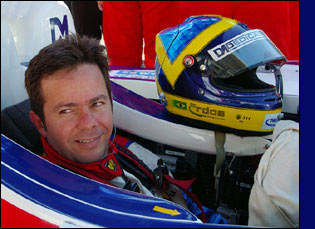 Tommy
shared the same gratitude for all the hard work
put in by the RML mechanics. Tommy
shared the same gratitude for all the hard work
put in by the RML mechanics.
“It’s all thanks to those guys. We’d
never have got there without them,” he said.
“They had a remarkable ability to deal with
everything that came along, and to do it quickly.
I admit, there were times in the middle when I
never thought we’d make it, but towards
the end I started thinking that perhaps there
was a chance. Even so, I was looking on P2 as
being the best we could probably hope for, and
I was more than prepared to be satisfied with
that. At least that would have secured us an entry
for next year.”
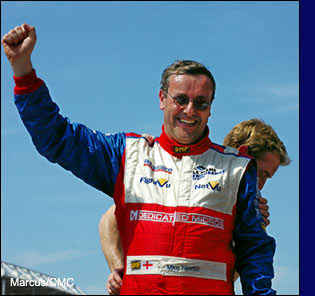 As
for the car’s third driver, well, the grin
never left Mike Newton’s face for what must
have been the best part of an hour. It was a pleasure
to see him so delighted, and to know that he had
played a significant role in his team’s
success. There have been certain people, those
who don’t look too closely at the figures,
perhaps, who have dismissed Mike as a driver,
but they’d be wrong to do so. Put anyone
alongside a pairing like Tommy and Warren, and
unless they were diehard professionals, they’d
all run the risk of looking slow. Mike never pretends
to be more than he is; an enthusiastic gentleman
driver, but perhaps that alone is where he falls
short. Weighed against those of others on the
track at the same time, professionals included,
his times compare very well indeed. If his best
race laps only occasionally dipped below four
minutes, they were consistent, and typically came
through several seconds quicker than those of
his immediate rivals in LMP2. He didn’t
shirk his duties either, and completed over five
and a half hours at the wheel; only two stints
less than Warren. He had every reason to look
fulfilled. As
for the car’s third driver, well, the grin
never left Mike Newton’s face for what must
have been the best part of an hour. It was a pleasure
to see him so delighted, and to know that he had
played a significant role in his team’s
success. There have been certain people, those
who don’t look too closely at the figures,
perhaps, who have dismissed Mike as a driver,
but they’d be wrong to do so. Put anyone
alongside a pairing like Tommy and Warren, and
unless they were diehard professionals, they’d
all run the risk of looking slow. Mike never pretends
to be more than he is; an enthusiastic gentleman
driver, but perhaps that alone is where he falls
short. Weighed against those of others on the
track at the same time, professionals included,
his times compare very well indeed. If his best
race laps only occasionally dipped below four
minutes, they were consistent, and typically came
through several seconds quicker than those of
his immediate rivals in LMP2. He didn’t
shirk his duties either, and completed over five
and a half hours at the wheel; only two stints
less than Warren. He had every reason to look
fulfilled.
In
every respect, this was a fantastic team effort
by everyone at RML, amply supported by Lola, Judd
and Michelin. It just seems such huge injustice
that the name of MG will appear in the annals
of Le Mans history two months too late, for here
is a story that deserves a bigger audience and
far greater recognition.
Back
to top
Marcus
Potts |
